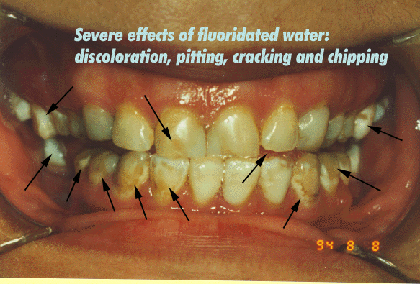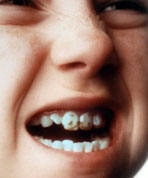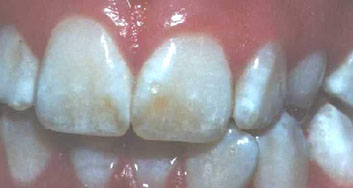Dental fluorosis : a consequence of water fluoridation caused exclusively from excessive fluoride. |
 |
| Dental fluorosis from Fluoridated water : the future look of Bellingham resident's teeth? |
|
|
| Dentist David Kennedy discusses how fluoridated water causes fluorosis, expected dental fluorosis rates in fluoridated communities, and the costs of correcting dental fluorosis damage.
The opaque white spots and brown ugly discoloration on the teeth of the young lady pictured here (one of my patients) is a case of dental fluorosis resulting from fluoridation.
The structural damage to her fluorotic teeth can never be repaired. The cosmetic damage can only be corrected by replacing the fluorotic enamel with porcelain veneers and crowns at a cost of $600 per tooth times 28 teeth or about $16,000 for this young lady. Replacement of crowns and reapplication of the veneers could bring the lifetime cost of repairing this damage to $30,000 or more. On average, 10 teeth will be affected that will need repair at a cost of $6000 initially and at least $15,000 over a lifetime.
As a result of fluoridation, 150,000 children (30% of the approximately 500,000 children at each 1 -year age group) will fall victim to dental fluorosis each year. This will result in an initial cost of $6000 X 150,000 or 900 million dollars per year! As maintenance is added in over a lifetime, this figure will increase to 3.3 billion dollars per year, in 1995 dollars, after 70 years, assuming the population of children does not change. And remember, this only corrects for cosmetic damage. The structural damage resulting from dental fluorosis can never be repaired. Nor can the psychological damage that results from these unsightly teeth.
To make things worse, we have known for years that malnourished and minority children are most susceptible to dental fluorosis. In 1952, Maury Massler and Isaac Schour, two of the most prestigious dentists in the United States at that time, published a paper showing that while well-nourished children drinking fluoridated water experienced a dental fluorosis rate of 25%, poorly nourished children experienced a fluorosis rate of 60% (Journal of the American Dental Association 44:156165 (1952)).
If you really want to dramatically reduce tooth decay, pass a bill that enables a team of hygienist to apply sealants to the vulnerable biting surfaces of the permanent teeth. Make this quality care available for every child in California at a fraction of the cost you are now paying to treat dental disease. Sealants seal out decay before it destroys the integrity of the tooth. This method is 100% successful in preventing decay where the sealant remains intact.(Simonsen JADA 100:535-539, 1980) If it wears off then just reseal the tooth again. No drilling, no mutilation, no shots, no trauma, no tears, no disease. Why are we not doing this already you ask?
A licensed dentist or the hygienist under the supervision of a dentist must apply the sealant. Many insurance companies will not pay for sealants including welfare. The cost is relatively high since the dentist and attendant overhead must be compensated. This proven technology is noninvasive, requires no shots or drilling and produces no harmful side effects.
David Kennedy, D.D.S.
(619) 231-1624
2425 Third Avenue
San Diego, CA 92101 |
| |
The Health Risks of Water Fluoridation Are Significant.
The most common and identifiable health risk from fluoridation is dental and skeletal fluorosis.
Dental and skeletal fluorosis are well documented debilitative conditions caused from excess fluoride. See fluoridation.com.
"A linear correlation between the Dean index of dental fluorosis and the frequency of bone fractures was observed among both children and adults."
- Alarcon-Herrera MT, et al. (2001). Well Water Fluoride, Dental fluorosis, Bone Fractures in the Guadiana Valley of Mexico. Fluoride 34(2): 139-149. |
 |
| "Moderate" fluorosis requiring dental vaneers |
|
Q & A on Dental Fluorosis:
"My child has dental fluorosis. What can we do to fix it?"
The damage that dental fluorosis causes to the internal matrix of the teeth is permanent. There is no way to reverse this damage.
However, there are ways to 'hide the damage' -- to treat the surface of the teeth so as to hide the discoloration.
Treatment options for fluorosis vary and will depend in part on the severity of the fluorosis and what you can afford (some of the treatments are very expensive). Some of the more common treatments include:
- Abrasion: Abrasion involves finely sanding off the outer layer of the enamel. It is a common approach when the fluorosis is mild. However, if the fluorosis is of a more advanced severity, abrasion is probably not a good idea as it can bring to the surface of the teeth a highly-porous enamel that will be prone to attrition.
- Composite bonding: Composite bonding first involves lightly roughening the area of the damaged enamel. After etching the enamel, a composite resin (with a color matching your teeth) is "glued" on to the exterior of the tooth.
- Porcelain veneers/laminates: Made out of porcelain, veneers form a ceramic shell over the surface of the tooth. Veneers may need to be replaced after several years, however, which can become quite expensive.
To determine which method of treating fluorosis will be best for you, contact your local dentist. If your dentist doesn't specialize in cosmetic dentistry, he/she should be able to refer you to a nearby dentist who does.
fluoridealert.org/dental-fluorosis.htm. |
Question : What degree of dental fluorosis are you willing to live with?
Table I Degrees of Dental Fluorosis (5,6)
| Category |
Description of Aberration |
Weighting Factor |
| None (Normal) |
Enamel smooth, glossy, pale creamy white translucency |
0.0 |
| Questionable |
Slight aberrations from translucency with occasional white fleck or spots |
0.5 |
| Very Mild |
Small, opaque, paper-white areas involving less than 25% of the surfaces of the two most affected teeth; may acquire brown stains in adulthood |
1.0 |
| Mild |
More extensive dull white opacities involving less that 50% of the surfaces of the two most affected teeth; Brown staining often present |
2.0 |
| Moderate |
All enamel surfaces affected; distinct brown staining frequent |
3.0 |
| Severe |
Teeth show marked hypoplasia, attrition and pitting; brown or black staining widespread |
4.0 |
According to Dean, the preferable community index should not exceed 0.4 and at 0.6 "...it begins to constitute a public health problem." Waldbott comments (5) on both the weighting factors used and the justification thereof by stating:
".....Although in theory such calculations are attractive, in reality they are misleading. The community index of dental fluorosis does not accurately represent the true state of mottling in a community. It gives the same weight to eight questionable (0.5) cases as to one severe case (4.0); it counts three mild (2.0) or six very mild (1.0) cases as equal to two moderate (3.0) ones ....... For the individual with an unsightly degree of mottling, it is of no comfort to know that the community index of dental fluorosis is below 0.6 or even below 0.4! This dilemma was clearly perceived by Cox, who first explicitly advocated fluoridation, when he wrote: `...With the threat of the Scylla and Charybdis of dental caries and mottled enamel, great caution must be observed in the means of administration of fluorides and in the control of such procedures as may be adopted'..."
|
 |
| Severe staining from fluorosis |
|
Dental Fluorosis rates in Fluoridated cities
"The prevalence of fluorosis in permanent teeth in areas with fluoridated water has increased from about 10-15% in the 1940s to as high as 70% in recent studies..."
SOURCE: Marshall TA, et al. (2004). Associations between Intakes of Fluoride from Beverages during Infancy and Dental Fluorosis of Primary Teeth. Journal of the American College of Nutrition 23:108-16.
"Current studies support the view that dental fluorosis has increased in both fluoridated and non-fluoridated communities. North American studies suggest rates of 20 to 75% in the former and 12 to 45% in the latter."
SOURCE: Locker, D. (1999). Benefits and Risks of Water Fluoridation. An Update of the 1996 Federal-Provincial Sub-committee Report. Prepared for Ontario Ministry of Health and Long Term Care.
"Systemic F-exposure to children has increased. Mild dental fluorosis is now more common than one would predict on the basis of Dean's findings in the late 1930s and early 1940s: in fluoridated and non-fluoridated communities. Several recent studies report prevalence rates in the 20 and 80 percent range in areas with fluoridated water."
SOURCE: Luke J. (1997). The Effect of Fluoride on the Physiology of the Pineal Gland. Ph.D. Thesis. University of Surrey, Guildford. |
Table II - Percentages of Children with Dental Fluorosis
"Optimal" Fluoride
Communities |
Age Range
of Children |
F Conc. (ppm) |
Percent of
Fluorosis |
Ref. (Note b) |
| Auckland (NZ) |
7-12 |
1.0 |
25 |
(2) |
| Auckland Region (NZ) |
9 |
1.0 |
25 |
(3) |
| Hastings (NZ) |
10 |
1.0 |
23 |
(5) |
| Kewanee, IL |
13-15 |
1.0 |
28 |
(12) |
| Kerrville, TX |
7-18 |
1.4 |
16 |
(14) |
| Angleton, TX |
7-18 |
1.3 |
33 |
(14) |
| Alvin, TX |
7-18 |
1.3 |
29 |
(13) |
| Kingsvllle, TX |
7-18 |
1.0 |
39 |
(13) |
| Richmond, Ml |
6-12 |
1.2 |
51 |
(13) |
| Redford, IL |
6-12 |
1.0 |
48 |
(13) |
| Hudson, Ml |
6-12 |
0.8 |
32 |
(13) |
| New York State |
12-17 |
1.0 |
27 |
(15) |
Low Fluoride
Communities: |
Age Range
of Children |
F Conc. (ppm) |
Percent of
Fluorosis |
Ref. (Note b) |
| Richmond (NZ) |
12-14 |
0.2 |
6 |
(I) |
| Auckland (NZ) |
7-12 |
0.2 |
4 |
(2) |
| Auckland Region (NZ) |
9 |
0-0.2 |
15 (Note a) |
(3) |
| Napier (NZ) |
10 |
0-0.2 |
3 |
(15) |
| Iowa towns |
8-16 |
0.0 |
3 |
(10) |
| San Antonio, TX |
7-18 |
0.4 |
2 |
(14) |
| San Marcos, TX |
7-18 |
0.3 |
8 |
(14) |
| N. Braunfels, TX |
7-18 |
0.3 |
9 |
(14) |
| Cadillac, MI |
6-12 |
0.0 |
12 |
(13) |
| New York State |
12-17 |
0-0.3 |
4 |
(15) |
|
Note a) 55% of the children received fluoride supplements.
Note b) References in the last column of the above table are taken from Ref. 14
Ref: |
Should Natick Fluoridate?
A Report to the Town and the Board of Selectmen
Prepared by the Natick Fluoridation Study Committee
13 E. Central Street, Town of Natick, MA October 23, 1997 |
 |
| Significant enamel damage and staining from fluorosis |
|
Dental Fluorosis - Definition and Mechanism
Excessive ingestion of fluoride during the early childhood years may damage the tooth-forming cells, leading to a defect in the enamel known as dental fluorosis.
Teeth impacted by fluorosis have visible discoloration, ranging from white spots to brown and black stains.
Teeth with fluorosis also have an increased porosity of the enamel. In the milder forms, the porosity is mostly limited to the sub-surface enamel, whereas in the more advanced forms, the porosity impacts the surface enamel as well, resulting in extensive pitting, chipping, fracturing, and decay of the teeth.
The discoloration induced by fluorosis - particularly in its advanced forms - can cause significant embarrassment and stress to the impacted child, resulting in adverse effects on esteem, emotional health, and career success.
It is currently estimated that an average of 48% of children living in fluoridated areas now have some form of dental fluorosis, with 12.5% of children having fluorosis significant enough to be of "esthetic concern" (York Review, 2000).
While proponents of water fluoridation dismiss dental fluorosis as being simply a "cosmetic effect," recent research indicates that the rate of bone fracture among children with fluorosis (even in the mild forms) is higher than the bone fracture rates among children with no fluorosis.
As noted by Dr. Hardy Limeback, Head of Preventive Dentistry at the University of Toronto, "it is illogical to assume that tooth enamel is the only tissue affected by low daily doses of fluoride ingestion."
To learn more about dental fluorosis, read the letter of Dr. Debra Hopkins or see
www. fluoridealert.org. |
| To help protect Bellingham's Drinking Water
Send an email to member@noforcedfluoride.org and volunteer.
Send Donations to
Danelle Weaver, Tresurer
Healthy Goals for Bellingham
2716 St. Claire St.
Bellingham, WA 98226-4004
(Registered PAC with the Washington State Public Disclosure Commission) |
|